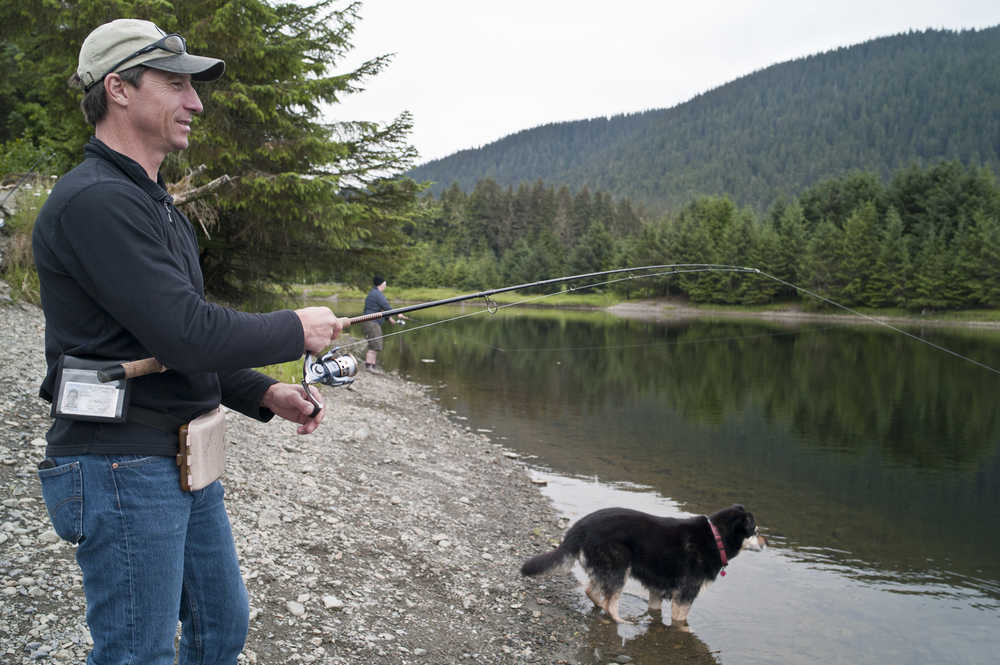Commercial gillnet fisherman Tim Mosher drew a line on his GPS plotter, cutting Taku Sound in half. The line marks a boundary the Alaska Department of Fish and Game placed in advance of Sunday’s first gillnet opening to protect the lowest ever recorded king salmon returns on the Taku River.
In his 25 years fishing, Mosher has never seen the area cut back so heavily, though he understands the reasoning.
“I think they’re doing the best they can to preserve the chinooks, and it’s real tough after having shut down the sport fishermen to not shut us down too,” Mosher said. “It’s just gonna make it more crowded but the good news is they’re trying to get us a shot at the sockeyes and dogs, which is what we’re after, and let every king they can get by.”
ADF&G is restricting gillnetters from setting their nets in the western half of Taku Inlet, keeping them from lucrative fishing grounds near Bishop Point. Sport fishing on the river was shut down June 2.
The thinking behind these drastic cuts in fishing access is simple: the Taku River is showing the lowest king salmon returns since the Pacific Salmon Commission started tracking fish counts on the river in 1989. Officials from the ADF&G expects only 12,000-13,000 Taku River chinook salmon to make it to their spawning grounds this year, falling well short of their 19,000-36,000 management range.
In the 27 years of recorded data on the Taku River, escapement numbers have averaged nearly 42,000 fish. A record high of 114,938 fish made it up river in 1997 while 2007 marked the previous low at 14,749.
The record low numbers frighten ADF&G, but is it a cause for panic in the fishing community?
“You’ve got your different degrees,” said ADF&G Juneau Area Management Biologist Dave Harris. “We’re definitely concerned about these low numbers. We’ve been struggling with our escapement goals across the state and we’re no different. Last year we had a glimmer of hope, like we were coming out of that low productivity trend, so it’s surprising that this year is coming in so low.”
In addition to the Taku, the Stikine and Unuk rivers are showing early signs of a poor returns as well. Biologists aren’t sure what’s causing the low wild chinook numbers, but they have some ideas.
“Something is occurring out in the ocean that we are unsure of. We suspect it has to do with the warm water temperatures affecting the food chain offshore,” Harris said. “We don’t have definitive proof of that but that’s a large ecological anomaly that we can point to that is occurring. You’re always looking for what it could possibly be, sometimes there were poorer smolts that went out or other things you can point at that will indicate you had a poor return coming, but everything seemed like it was improving. There were no alarm bells coming into the season, it’s just everything has been much lower than anticipated.”
Harris said the higher ocean temperatures could have something to do with what’s called
Pacific Decadal Oscillation, or PDO, an El Niño-like pattern of Pacific climate variability. Biologists believe salmon are coming out of a less-productive cycle of PDO, but numbers on the Taku River suggest otherwise.
“People are trying to figure out what drives these cycles (in fish returns), potentially the PDO,” Harris said. “It’s kind of like ocean climate and it kind of alternates from a cold and a warm phase in a real broad look at the ocean. When it’s on one phase, things are more productive, and when it switches over to another phase, things are less productive, and this is one of the natural cycles in the world. We thought that we were coming out of a period of poor production, but this year is a surprise.”
Though the low numbers are scaring biologists, one bad year won’t kill the entire stock. Returning king salmon populations consist of multiple age groups, or “brood years.” This season’s scant generation will return to spawn with, hopefully, four to eight more generations of healthier numbers.
“When you start getting successive years of low returns, that’s when you start getting a dangerous situation,” Harris said.
• Contact reporter Kevin Gullufesn at 523-2228 or at kevin.gullufsen@juneauempire.com.

